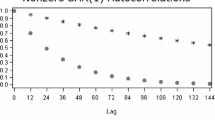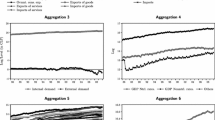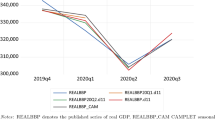Abstract
This paper examines the implications of the seasonal adjustment by an ARIMA model based (AMB) approach in the context of seasonal fractional integration. According to the AMB approach, if the model identified from the data contains seasonal unit roots, the adjusted series will not be invertible that has serious implications for the posterior analysis. We show that even if the ARIMA model identified from the data contains seasonal unit roots, if the true data generating process is stationary seasonally fractionally integrated (as it is often found in economic data), the AMB seasonal adjustment produces dips in the periodogram at seasonal frequencies, but the adjusted series still can be approximated by an invertible process. We also perform a small Monte Carlo study of the log-periodogram regression with tapered data for negative seasonal fractional integration. An empirical application for the Spanish economy that illustrates our results is also carried out at the end of the article.


Similar content being viewed by others
Notes
Recently, Eurostat has harmonised seasonal adjustment practices with the development of Demetra+ which currently includes both X-12-ARIMA and TRAMO-Seats.
It is applied to the historical or final estimator of the SA series. However, only the central observations of the SA series are produced by the historical estimator. For the periods close to the beginning or the end, the filter cannot be completed and some preliminary estimator has to be used. If the series is long its properties are dominated by the final estimator. However, if it is short it will have a highly nonlinear structure.
We analyse the process (10) instead of (9) because of two reasons. First, in empirical econometrics, two-sided processes are very rare and are not estimated in practice. Second, given that the estimation techniques employed in the paper are based on the (pseudo) spectrum of a process, then (10) cannot be virtually distinguished from (9).
We exclude 40 observations from the beginning and from the end of series to eliminate nonlinearities produced by preliminary estimator of SA.
The construction of a joint test is difficult. Note that even if one assumes independence, the testing procedures would still require a one-tailed joint test. Wald tests based on chi-squared distributions cannot easily accommodate directional tests. More important, statistically invertibility requires the rejection of the null \(H_0 :d_i \le -0.5\) for the two seasonal FI parameters. In a standard joint test, the alternative would take the form \(H_1 :d_1>-0.5\hbox { or }d_2 >-0.5\) thus the rejection of the null does not guarantee statistical invertibility.
Recall that the original data was yearly differenced in the Monte Carlo analysis to ensure that the resulting series are overdifferenced at seasonal frequencies with negative coefficients of fractional integration. For the processes with the fractional order of integration at zero \(d_0 =1.5\), we take a first difference in addition to the yearly difference. The same applies to the Airline model.
The quality of the approximation depends on the DGP and the model chosen by TSW to fit the data. According to the simulation results, this approximation is expected to be reliable for \(d_1 ,d_2 \in \left[ {0,1} \right] \), which are the values employed in our study. For these values, \(\delta _1 \) and \(\delta _2 \) usually belong to the \(\left[ {0,1} \right] \) interval (see Table 2).
We have selected the parameterizations of the SARFIMA and Airline models for illustrative purposes. The parameterization of the Airline selected by the TSW depends on the particular realization of the data. Thus, there might be another parameterization of the Airline model that constitutes a better integer approximation to the SARFIMA in the table.
For \(j=0\) and \(j=T/2\), \(\upsilon _j \) is distributed \(\chi _1^2 \). However frequencies zero and \(\pi \) are not required for this test. See Berkowitz and Diebold (1998) for the details on the bootstrap in frequency domain.
These percentages depend both on T and the bandwidth. For larger T and smaller bandwidth, the null is rejected more often. However, practical applications with \(T>500\) (more than 125 years of data) are rare. A smaller bandwidth implies fewer points for testing, which influences significantly the quality of the test. Thus, it has sense only if T is very large.
In particular the analysed series have the following lengths. HS: 1970:1-2006:4; CR: 1970:1-2007:4; CC: 1970:1-2007:4; ln(IPI): 1975:1-2007:4; ln(AIR): 1970:1-2008:4; EMP: 1964:1-2007:4. Note that for HS, an additional year is taken since the effects of the crisis manifest earlier. On the contrary, we have been able to use an additional year for airline passengers (AIR) and employment (EMP). Nevertheless, the estimation results including the period of the crisis are available under request.
References
Arteche J (2003) Semiparametric robust tests on seasonal or cyclical long memory time series. J Time Ser Anal 23:251–285
Arteche J, Robinson PM (2000) Semiparametric inference in seasonal and cyclical long memory processes. J Time Ser Anal 21:1–25
Arteche J, Velasco C (2005) Trimming and tapering semi-parametric estimates in asymmetric long memory time series. J Time Ser Anal 26:581–611
Berkowitz J, Diebold FX (1998) Bootstrapping multivariate spectra. Rev Econ Stat 80:664–666
Bhardwaj G, Swanson NR (2006) An empirical investigation of the usefulness of ARFIMA models for predicting macroeconomic and financial time series. J Econom 131:539–578
Box GEP, Jenkins GM (1970) Time series analysis: forecasting and control. Holden-Day, San Francisco
Bujosa M, García-Ferrer A, de Juan A (2013) Predicting recessions with factor linear dynamic harmonic regressions. J Forecast 32:481–499
Eurostat (2009) ESS guidelines on seasonal adjustment. European Communities, Luxembourg
Gil-Alana LA, Robinson PM (2001) Testing of seasonal fractional integration in the UK and Japanese consumption and income. J Appl Econom 16:95–114
Gomez V, Maravall A (2001) Seasonal adjustment and signal extractions in economic time series. In: Peña D, Tiao DG, Tsay RS (eds) A course in advanced time series analysis. Wiley, New York, pp 171–201
Grether DM, Nerlove M (1970) Some properties of optimal seasonal adjustment. Econometrica 38:682–703
Hassler U, Rodrigues P, Rubia A (2009) Testing for general fractional integration in the time domain. Economet Theor 25:1793–1828
Hurvich CM, Ray BK (1995) Estimation of the memory parameter for non-stationary or non-invertible fractionally integrated processes. J Time Ser Anal 16:17–41
Hurvich CM, Chen WW (2000) An efficient taper for potentially overdifferenced long-memory time series. J Tim Ser Anal 21:155–180
Leamer EE (2009) Macroeconomic patterns and stories. Springer, Berlin
Maravall A (2009) identification of Reg-ARIMA models and of problematic series in large scale applications program TSW. Mimeo, Bank of Spain, Statistic and Econometric Software
Nerlove M (1965) A comparison of a modified’ Hannan’ and the BLS seasonal adjustment filters. J Am Stat Ass 60:442–491
Ooms M, Hassler U (1997) On the effect of seasonal adjustment on the log-periodogram regression. Econ Lett 56:135–141
Porter-Hudak S (1990) An application of the seasonal fractionally differenced model to the monetary aggregates. J Am Stat Ass 85:338–344
Sidak ZK (1967) Rectangular confidence regions for the means of multivariate normal distributions. J Am Stat Ass 62:626–633
Velasco C (1999) Non-stationary log-periodogram regression. J Econom 91:325–371
Whittle P (1963) Prediction and regulation by linear least-square methods. English Universities Press, London
Author information
Authors and Affiliations
Corresponding author
Additional information
We thank two anonymous reviewers for comments and suggestions. The usual disclaimer applies. Luis Gil-Alana also acknowledges financial support from the Spanish Ministry of Education Grant ECO2011-2014 ECON Y FINANZAS.
Rights and permissions
About this article
Cite this article
Lovcha, Y., Perez-Laborda, A. & Gil-Alana, L. On the invertibility of seasonally adjusted series. Comput Stat 33, 443–465 (2018). https://doi.org/10.1007/s00180-017-0715-5
Received:
Accepted:
Published:
Issue Date:
DOI: https://doi.org/10.1007/s00180-017-0715-5




